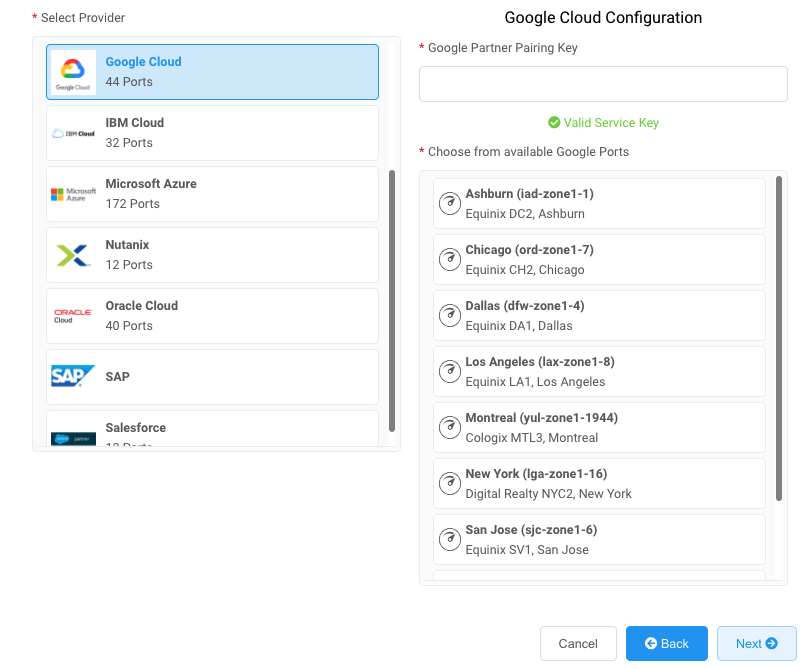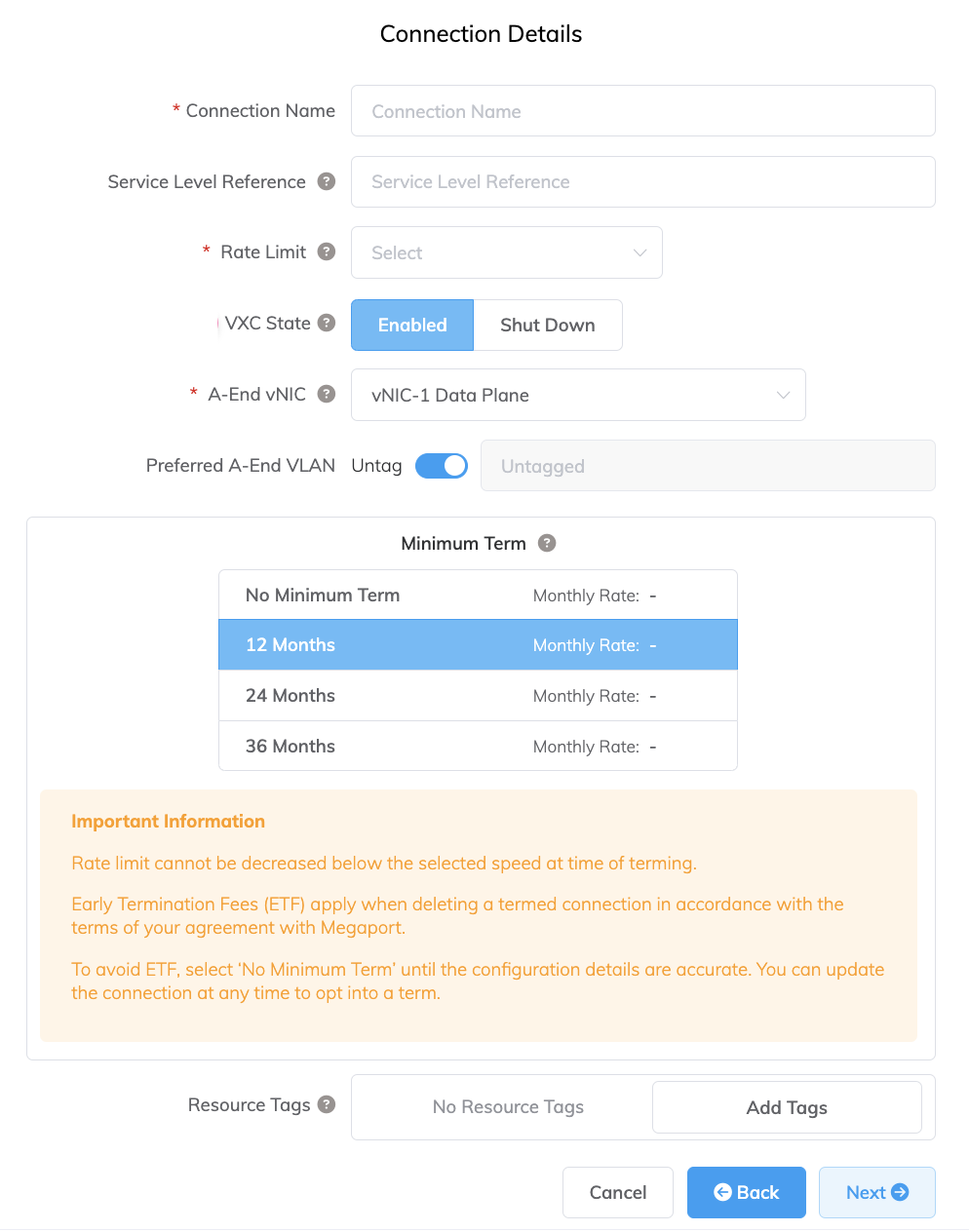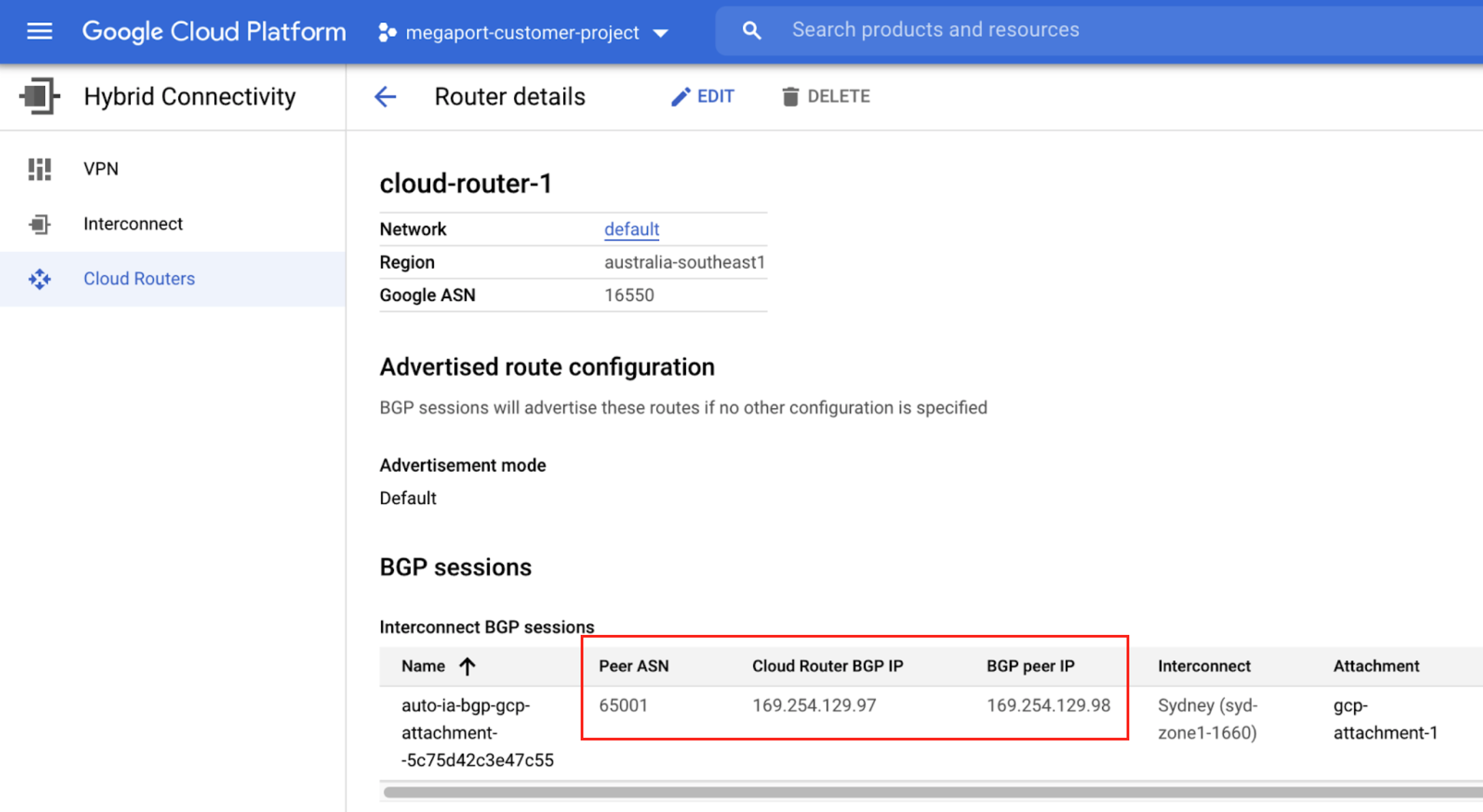Creating a Google Cloud Services Connection for an MVE with Aviatrix Secure Edge
You can create a network connection from an MVE with Aviatrix Secure Edge to Google Cloud through Partner Interconnect.
When connecting to Google Cloud Platform (GCP) through Partner Interconnect with Megaport, the Virtual Cross Connect (VXC) forms the Layer 2 component of the connection and Layer 3 BGP is established directly between the customer and GCP.
Important
Before you begin, create an MVE. For more information, see Creating an MVE Integrated with Aviatrix. The MVE needs to be in the active state.
There are three parts to adding a Google Cloud connection to your MVE and Aviatrix CoPilot.
-
Create a Partner Interconnect attachment in Google Cloud Console or gcloud CLI. Copy the pairing key that is provided as part of the attachment creation. For more information, see the Google documentation on Google Partner Interconnects.
-
In the Megaport Portal, create a VXC from your MVE to connect to your Google Cloud attachment.
-
In Aviatrix CoPilot, configure an interface and Border Gateway Protocol (BGP).
Note
MVE for Aviatrix Secure Edge requires configuration steps in both Aviatrix CoPilot and the Megaport Portal for all cloud connections.
Adding the Google Cloud connection in the Megaport Portal
To set up the Google Cloud Platform connection, you need to create the connection in the Megaport Portal.
To deploy a VXC to GCP from the Megaport Portal
- In the Megaport Portal, go to the Services page and select the MVE for the connection.
-
Click +Connection then click Cloud.

-
Select Google as the service provider.

-
Copy and paste the pairing key from the Google Cloud console into the Google Partner Pairing Key field on the right.
The relevant Google targets appear based on the region of your GCI Partner connection. -
Select the target location for your connection then click Next.
-
Specify the connection details:
-
Connection Name – The name of your VXC to be shown in the Megaport Portal.
-
Service Level Reference (optional) – Specify a unique identifying number for your Megaport service to be used for billing purposes, such as a cost center number, unique customer ID, or purchase order number. The service level reference number appears for each service under the Product section of the invoice. You can also edit this field for an existing service.
-
Rate Limit – The speed of your connection in Mbps. The speed cannot be changed once deployed. Enter the same rate you selected for your Google port speed.
-
VXC State – Select Enabled or Shut Down to define the initial state of the connection. For more information, see Shutting Down a VXC for Failover Testing.
Note
If you select Shut Down, traffic will not flow through this service and it will behave as if it was down on the Megaport network. Billing for this service will remain active and you will still be charged for this connection.
-
A-End vNIC – Select an A-End vNIC from the drop-down list. For more information about vNICs, see Creating an MVE in the Megaport Portal.
-
Preferred A-End VLAN – The VLAN for this connection that you will receive through the MVE. This must be a unique VLAN ID on this MVE and can range from 2 to 4093. If you specify a VLAN ID that is already in use, the system displays the next available VLAN number. The VLAN ID must be unique to proceed with the order. If you don’t specify a value, Megaport will assign one.
-
Minimum Term – Select No Minimum Term, 12 Months, 24 Months, or 36 Months. Longer terms result in a lower monthly rate. 12 Months is selected by default. Take note of the information on the screen to avoid early termination fees (ETF).
Enable the Minimum Term Renewal option for services with a 12, 24, or 36-month term to automatically renew the contract at the same discounted price and term length at the end of the contract. If you don’t renew the contract, at the end of the term, the contract will automatically roll over to month-to-month contract for the following billing period, at the same price, without term discounts.
For more information, see VXC Pricing and Contract Terms and VXC, Megaport Internet, and IX Billing.
-
Resource Tags – You can use resource tags to add your own reference metadata to a Megaport service.
To add a tag:- Click Add Tags.
- Click Add New Tag.
- Enter details into the fields:
- Key – string maximum length 128. Valid values are a-z 0-9 _ : . / \ -
- Value – string maximum length 256. Valid values are a-z A-Z 0-9 _ : . @ / + \ - (space)
- Click Save.
If you already have resource tags for that service, you can manage them by clicking Manage Tags.
Warning
Never include sensitive information in a resource tag. Sensitive information includes commands that return existing tag definitions and information that will identify a person or company.

-
-
Click Next to add the VXC to your order and complete the checkout process.
-
Once you have deployed the VXC, go back to your attachment in the Google Cloud Console and accept it.
You will be provided your private IP address from Google to configure BGP.
Ensure that you pre-activate the attachment or mark the attachment as active after configuring the VXC. Otherwise, you cannot set up BGP with your product.
Note
The Google ASN will always be 16550.
Adding the Google Cloud connection to Aviatrix
After you create the connection from your MVE to Google Cloud and set up the connection in the Google console, you need to configure it in Aviatrix. This involves configuring BGP settings, ASNs, and VLANs.
To add the Google Cloud connection in Aviatrix
-
Google Connection Details
Collect the connection details from the Google console for the connection you created.
Note the values for the Peer ASN, Cloud Router BGP IP, and BGP Peer ID.

-
Megaport Connection Details
Collect the A-End vNIC details associated with the Google connection from the Megaport Portal. To display the details, click the gear icon for the Google connection from your MVE then click the Details view.
Note the A-End vNIC value associated with the Google connection. Aviatrix orders vNICs in the same order they are created in the Megaport Portal. For example:
- 0: eth0
- 1: eth1
- 2: eth2
Collect the vNIC number associated with the connection, as this number will be used to associate the Aviatrix interface with the same number. For example, vNIC 0 in the Megaport Portal corresponds to eth0 in Aviatrix.
Note
Ensure all vNICs remain untagged as the Aviatrix MVE does not support VLAN tagging.
-
Aviatrix CoPilot Configuration
Log in to Aviatrix and configure Aviatrix CoPilot with the details you have copied.
For more information, see the Aviatrix Documentation.
Validation
- Use CoPilot’s diagnostic tools to review connection details and perform a ping test to check IP connectivity to Google.
- Verify that BGP is established using BGP diagnostics and relevant BGP CLI commands.